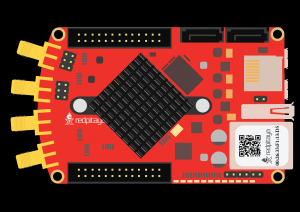2.3.6.3.4. Custom waveform signal generation
2.3.6.3.4.1. Description
This example shows how to program Red Pitaya to generate a custom waveform signal. Voltage and frequency ranges depend on the Red Pitaya model.
Note
You can send fewer samples than a full buffer (16384 samples) to the Red Pitaya, but the frequency will be adjusted accordingly. This means that if you send 8192 samples instead and specify the frequency as 10 kHz, Red Pitaya will generate a 20 kHz signal.
2.3.6.3.4.3. SCPI Code Examples
2.3.6.3.4.3.1. Code - MATLAB®
The code is written in MATLAB. In the code, we use SCPI commands and TCP client communication. Copy the code from below into the MATLAB editor, save the project, and hit the “Run” button.
%% Define Red Pitaya as a TCP client object
clc
clear all
close all
IP = '192.168.178.102'; % Input IP of your Red Pitaya...
port = 5000;
RP = tcpclient(IP, port);
flush(RP); % Flush input and output
% flush(RP, 'input')
% flush(RP, 'output')
%% Open connection with your Red Pitaya and the close previous one
x = instrfind;
clear RP;
RP = tcpclient(IP, port);
RP.ByteOrder = "big-endian";
configureTerminator(RP,"CR/LF");
%% Calculate arbitrary waveform with 16384 samples
% Values of arbitrary waveform must be in the range from -1 to 1.
N = 16383;
t = 0:(2*pi)/N:2*pi;
x = sin(t) + 1/3*sin(3*t);
y = 1/2*sin(t) + 1/4*sin(4*t);
plot(t,x,t,y)
grid on;
%% Convert waveforms to string with 5 decimal places accuracy
waveform_ch_1_0 = num2str(x,'%1.5f,');
waveform_ch_2_0 = num2str(y,'%1.5f,');
% the last two elements are empty spaces “,”.
waveform_ch_1 =waveform_ch_1_0(1,1:length(waveform_ch_1_0)-3);
waveform_ch_2 =waveform_ch_2_0(1,1:length(waveform_ch_2_0)-3);
% Reset Generation
writeline(RP,'GEN:RST') % Reset to default settings
%% GENERATION
writeline(RP,'SOUR1:FUNC ARBITRARY'); % Set function of output signal
writeline(RP,'SOUR2:FUNC ARBITRARY'); % {sine, square, triangle, sawu, sawd}
writeline(RP,['SOUR1:TRAC:DATA:DATA ' waveform_ch_1]) % Send waveforms to Red Pitya
writeline(RP,['SOUR2:TRAC:DATA:DATA ' waveform_ch_2])
writeline(RP,'SOUR1:VOLT 0.7'); % Set amplitude of output signal
writeline(RP,'SOUR2:VOLT 1');
writeline(RP,'SOUR1:FREQ:FIX 4000'); % Set frequency of output signal
writeline(RP,'SOUR2:FREQ:FIX 4000');
writeline(RP,'OUTPUT:STATE ON'); % Start both channels simultaneously
writeline(RP,'SOUR:TRig:INT'); % Generate triggers
clear RP;
2.3.6.3.4.3.2. Code - Python
Using just SCPI commands:
#!/usr/bin/env python3
import numpy as np
import math
from matplotlib import pyplot as plt
import redpitaya_scpi as scpi
IP = '192.168.178.102'
rp_s = scpi.scpi(IP)
wave_form = 'arbitrary'
freq = 10000
ampl = 1
N = 16384 # Number of samples
t = np.linspace(0, 1, N)*2*math.pi
x = np.sin(t) + 1/3*np.sin(3*t)
y = 1/2*np.sin(t) + 1/4*np.sin(4*t)
plt.plot(t, x, t, y)
plt.title('Custom waveform')
plt.show()
waveform_ch_10 = []
waveform_ch_20 = []
for n in x:
waveform_ch_10.append(f"{n:.5f}")
waveform_ch_1 = ", ".join(map(str, waveform_ch_10))
for n in y:
waveform_ch_20.append(f"{n:.5f}")
waveform_ch_2 = ", ".join(map(str, waveform_ch_20))
rp_s.tx_txt('GEN:RST')
rp_s.tx_txt('SOUR1:FUNC ' + str(wave_form).upper())
rp_s.tx_txt('SOUR2:FUNC ' + str(wave_form).upper())
rp_s.tx_txt('SOUR1:TRAC:DATA:DATA ' + waveform_ch_1)
rp_s.tx_txt('SOUR2:TRAC:DATA:DATA ' + waveform_ch_2)
rp_s.tx_txt('SOUR1:FREQ:FIX ' + str(freq))
rp_s.tx_txt('SOUR2:FREQ:FIX ' + str(freq))
rp_s.tx_txt('SOUR1:VOLT ' + str(ampl))
rp_s.tx_txt('SOUR2:VOLT ' + str(ampl))
rp_s.tx_txt('OUTPUT:STATE ON')
rp_s.tx_txt('SOUR:TRig:INT')
rp_s.close()
Using functions:
#!/usr/bin/env python3
import numpy as np
import math
from matplotlib import pyplot as plt
import redpitaya_scpi as scpi
IP = '192.168.178.102'
rp_s = scpi.scpi(IP)
wave_form = 'arbitrary'
freq = 10000
ampl = 1
N = 16384 # Number of samples
t = np.linspace(0, 1, N)*2*math.pi
x = np.sin(t) + 1/3*np.sin(3*t)
y = 1/2*np.sin(t) + 1/4*np.sin(4*t)
plt.plot(t, x, t, y)
plt.title('Custom waveform')
plt.show()
rp_s.tx_txt('GEN:RST')
# Function for configuring a Source
rp_s.sour_set(1, wave_form, ampl, freq, data= x)
rp_s.sour_set(2, wave_form, ampl, freq, data= y)
rp_s.tx_txt('OUTPUT:STATE ON')
rp_s.tx_txt('SOUR:TRig:INT')
rp_s.close()
Note
The Python functions are accessible with the latest version of the redpitaya_scpi.py document available on our GitHub. The functions represent a quality-of-life improvement as they combine the SCPI commands in an optimal order and also check for improper user inputs. The code should function at approximately the same speed without them.
For further information on functions please consult the redpitaya_scpi.py code.
2.3.6.3.4.4. API Code Examples
Note
The API code examples don’t require the use of the SCPI server. Instead, the code should be compiled and executed on the Red Pitaya itself (inside Linux OS). Instructions on how to compile the code and other useful information are here.
2.3.6.3.4.4.1. Code - C API
#include <stdio.h>
#include <stdlib.h>
#include <math.h>
#include "rp.h"
#define M_PI 3.14159265358979323846
int main(int argc, char **argv){
int i;
int buff_size = 16384;
/* Print error, if rp_Init() function failed */
if(rp_Init() != RP_OK){
fprintf(stderr, "Rp api init failed!\n");
}
float *t = (float *)malloc(buff_size * sizeof(float));
float *x = (float *)malloc(buff_size * sizeof(float));
float *y = (float *)malloc(buff_size * sizeof(float));
for(i = 1; i < buff_size; i++){
t[i] = (2 * M_PI) / buff_size * i;
}
for (int i = 0; i < buff_size; ++i){
x[i] = sin(t[i]) + ((1.0/3.0) * sin(t[i] * 3));
y[i] = (1.0/2.0) * sin(t[i]) + (1.0/4.0) * sin(t[i] * 4);
}
/* Reset Generation */
rp_GenReset();
/* Generation */
rp_GenSynchronise();
rp_GenWaveform(RP_CH_1, RP_WAVEFORM_ARBITRARY);
rp_GenWaveform(RP_CH_2, RP_WAVEFORM_ARBITRARY);
rp_GenArbWaveform(RP_CH_1, x, buff_size);
rp_GenArbWaveform(RP_CH_2, y, buff_size);
rp_GenAmp(RP_CH_1, 0.7);
rp_GenAmp(RP_CH_2, 1.0);
rp_GenFreq(RP_CH_1, 4000.0);
rp_GenFreq(RP_CH_2, 4000.0);
rp_GenOutEnableSync(True)
rp_GenSynchronise()
/* Releasing resources */
free(y);
free(x);
free(t);
rp_Release();
return 0;
}
2.3.6.3.4.4.2. Code - Python API
#!/usr/bin/python3
import time
import numpy as np
import rp
#? Possible waveforms:
#? RP_WAVEFORM_SINE, RP_WAVEFORM_SQUARE, RP_WAVEFORM_TRIANGLE, RP_WAVEFORM_RAMP_UP,
#? RP_WAVEFORM_RAMP_DOWN, RP_WAVEFORM_DC, RP_WAVEFORM_PWM, RP_WAVEFORM_ARBITRARY,
#? RP_WAVEFORM_DC_NEG, RP_WAVEFORM_SWEEP
channel = rp.RP_CH_1 # rp.RP_CH_2
channel2 = rp.RP_CH_2
waveform = rp.RP_WAVEFORM_ARBITRARY
freq = 10000
ampl = 1
N = 16384 # Number of samples in the buffer
##### Custom waveform setup #####
x = rp.arbBuffer(N)
y = rp.arbBuffer(N)
t = np.linspace(0, 1, N)*2*np.pi
x_temp = np.sin(t) + 1/3*np.sin(3*t)
y_temp = 1/2*np.sin(t) + 1/4*np.sin(4*t)
for i in range(0, N, 1):
x[i] = float(x_temp[i])
y[i] = float(y_temp[i])
# Initialize the interface
rp.rp_Init()
# Reset generator
rp.rp_GenReset()
###### Generation #####
rp.rp_GenWaveform(channel, waveform)
rp.rp_GenArbWaveform(channel, x.cast(), N)
rp.rp_GenFreqDirect(channel, freq)
rp.rp_GenAmp(channel, ampl)
rp.rp_GenWaveform(channel2, waveform)
rp.rp_GenArbWaveform(channel2, y.cast(), N)
rp.rp_GenFreqDirect(channel2, freq)
rp.rp_GenAmp(channel2, ampl)
#? Possible trigger sources:
#? RP_GEN_TRIG_SRC_INTERNAL, RP_GEN_TRIG_SRC_EXT_PE, RP_GEN_TRIG_SRC_EXT_NE
# Specify generator trigger source
rp.rp_GenTriggerSource(channel, rp.RP_GEN_TRIG_SRC_INTERNAL)
# Enable output synchronisation
rp.rp_GenOutEnableSync(True)
# Syncronise output channels
rp.rp_GenSynchronise()
# Release resources
rp.rp_Release()

